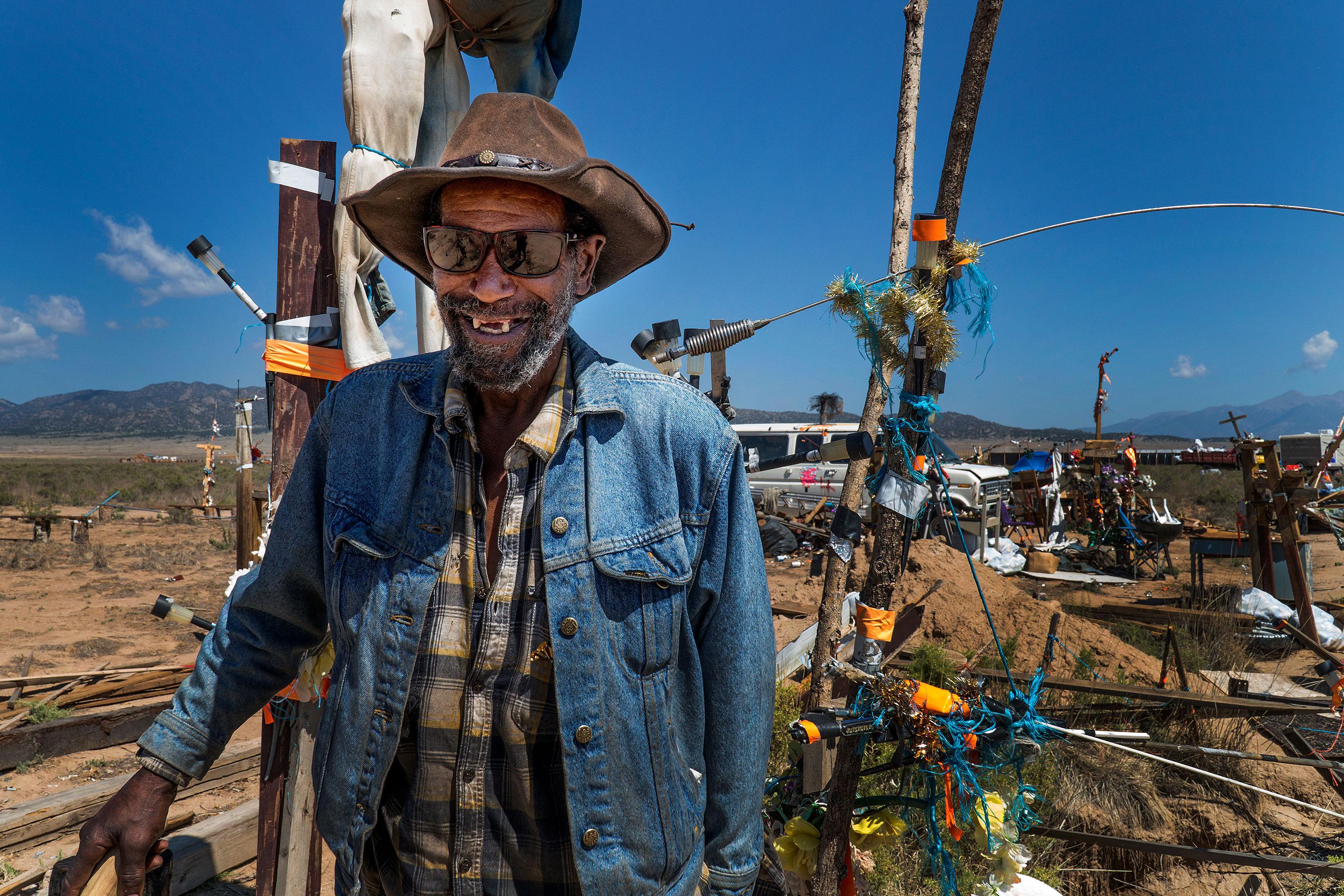

It’s a maze-like structure that twists and turns upon itself as it rises from the alkaline flats of the San Luis Valley. Garlands of aluminum cans wind around the wooden skeleton of this place; swaths of shimmering tinsel drape from tall posts. Everywhere you turn is a hodgepodge of tchotchkes — buttons, coins and small toys — glued to strips of wood that lean on the various structures.
Welcome to Fort Roy at Royville, population one.
Drive 20 minutes outside of Saguache and you’ll find the home of visual artist, musician and self-described hobo Roy L. Smith, known to many as Ramblin’ Roy. It took him a little more than a year to construct this art compound. He didn’t overthink it.
“I just get out there and start putting stuff together,” Smith said. “Whatever comes out, it’s gonna be nice, I figure. I just got that in my heart that it’s gonna come out nice.”

It’s a sentiment that perfectly sums up his philosophy toward his art in general. In Smith’s experience, when you’re focused “hard on how’s it gonna come out, it come out bad.” There’s another force at work with his latest laissez-faire aesthetic though. A fire last February torched his bus, beloved truck and parts of Fort Roy at Royville. The community raised money to buy a trailer to replace the damaged bus.
Yet this destruction also led to the creation of “art that made itself” — charred bits of action figures, VHS tapes, cameras, coins and such fused onto stripes of ashen wood.
“I didn’t do nothing to it,” Smith said. “The fire made it go the way it wanted it.”
Smith was born in 1946 in Gunnison, Mississippi. It’s a point in his life he doesn’t like to talk about: “Too much racism.” He was a witness to the Ku Klux Klan’s physical and verbal attacks on black people. At age seven, his mother encouraged him to leave and see the world.

“I was a hobo kid,” Smith said. “[I] rode the train and when I got tired of riding the train and I went a-stowawaying on ships. I went everywhere the ships went.”
The people he met on his travels taught how to play the guitar, to “strum on it until it sound good… and if it don’t sound right, then change the key and play it until it sound perfect.”
Wanderlust led him to Colorado in the mid-1960s, where he roamed the state performing his music. In the 70s, he settled in Gilpin County but he faced discrimination from some of his white neighbors, including being attacked by their dogs and being nearly run over. Reports to local law enforcement didn’t seem to help. It was later revealed that the sheriff’s office entered Smith in their database using a racial slur. Smith sued the county for racial discrimination and, in 1997, received a $700,000 settlement.
A 1998 ABC News 20/20 report called Smith’s ordeal “one of the most compelling civil rights cases in years.”
After he left Gilpin County, Smith landed in Salida and then later in the San Luis Valley, where Fort Roy at Royville stands today.

Smith believes the fire at Royville was also racially motivated. Both the Saguache County Sheriff Department and the local division of the Bureau of Alcohol, Tobacco, Firearms and Explosives investigated. The sheriff said they found no evidence of arson.
Lately, Ramblin’ Roy would rather focus on his artwork than his past.
Poet and University of Southern California English professor Mark Irwin recently saw Smith’s work for the first time during a summer exhibition at The Range in Saguache. Irwin said Smith has a remarkable intuition as an artist, one that reflects his resilience.
“Most people would have thrown all this away,” Irwin said of the sculptures of distressed and melted materials that formed in the February fire. “But from the complete destruction of his life, he’s like a phoenix risen out of the ashes… to find something beautiful in that ugliness is amazing.”
The Range helped publish a new book about Smith’s art called “Last Train for Freedom Leavin’ Town.”
Artist Gaby Wolodarski, who teaches in the art department at the University of Montevallo in Alabama, wrote a poem for the book. To her, Smith’s work “teaches us to see things.”

“I learn when I look at his work,” Wolodarski said, adding that the way Smith assembles these objects, which many would overlook, transforms them and makes you think about your place in the world. “And that’s wonderful because the world just got so much bigger.”
Raw experience has been Smith’s teacher, said Esteban Peralta, the managing director of DIY art gallery Peralta Projects. Peralta’s gallery will host an exhibition of Ramblin’ Roy’s work in collaboration with The Range through the end of December.
“There’s something about [Smith’s] work that is just not explainable,” Peralta said. “I think it’s different when you go to somewhere and you learn technique.”
A past marred by racism and hate may have shaped Smith and his art, but he’s also found freedom in creation. He hopes others can find some freedom in it too. Afterall, why be “negative, hateful and mean?” Ramblin’ Roy asks. “Go do some art.”









